Newsletter - June 2010
Burlington Historian

June 2010

Society Looking for Two or Three New Members of the Board of Directors
Two of the more recently elected members of the Society's board of directors have found it impossible for health or family reasons to continue to serve on the board. Another director has asked to be replaced but will continue to serve until a replacement is found. That means that the Society is looking for two or three people who would like to volunteer to become more active in the Historical Society.
The Society appreciates the service of Dennis Boyle and Jeff Kramer, who have found it necessary to resign as board members.
The board of directors is a twelve-member body which conducts the affairs of the Society, including the approval and authorization of the expenditures and the creation and implementation of policies for the development, operation, and maintenance of facilities.
The directors are usually elected by the members of the Society at the annual meeting. One third of the directorships become vacant each year and elections to these vacancies are for a period of three years. If vacancies occur before the expiration of a director’s term, the vacancy is filled by election of the other members of the board of directors and those so elected complete the term of the director they replace.
The board of directors meets on the first Wednesday of each month. Special meetings of the board may also be called by the president or by any three members of the board.
As stated in the Society’s articles of incorporation, the purposes of the Society are exclusively educational and are to preserve, advance, and disseminate knowledge of the history of the City of Burlington and the counties of Racine, Kenosha and Walworth.
If you are interested in becoming a member of the board of directors, please contact a current member (see box at left), send us a note or e-mail the Society at the addresses shown in the masthead, or leave your name on the Museum’s answering machine - 262-767-2884.
Ice Cream Social to be held July 31
The Society’s annual Ice Cream Social is scheduled to be held on Saturday, July 31, from 10 a.m. to 3 p.m., on the grounds near the Pioneer Cabin in Wehmhoff Square.
The event is held annually in conjunction with the City’s Maxwell Street Days. Ice cream cones and sundaes will be sold at very reasonable prices. Soda and water will also be available.
Society members or others who would like to help out are always welcome.
President’s Message
History is all around us and often overlooked. Drive down some of the residential alleys in town and you will see some early "barns" that are now used as garages. Entire blocks in the city were once small farms and then subdivided into individual lots that were sold to agents for home sales.
If you look at some of the foundations and exterior walls of older buildings, especially in the downtown area, you will notice many were "placed stone" construction. Since the razing of the buildings for the new hotel complex on Dodge Street, you will notice (in the rear) many of the original stone buildings of early merchants in that area.
If you look along the bank of the east side of the White River just off Milwaukee Avenue, you will see the foundation remnants of the rail bridge for the T.M.E.R.&L. electric line that crossed there from 1909 to 1938. There was no Milwaukee Avenue traffic bridge at that time. The only way for traffic going north was the bridge at the foot of E. Chestnut Street (near the Charcoal Grill and the old Burlington Cleaners).
As a reminder, we are always looking for older photos of Burlington area "Street Scenes" that may be in your family albums. Contact the museum and we will make arrangements to scan the photos of interest and return them to you. Thanks and have a great summer.
Dennis Tully
Scenes from the Summer of 1950
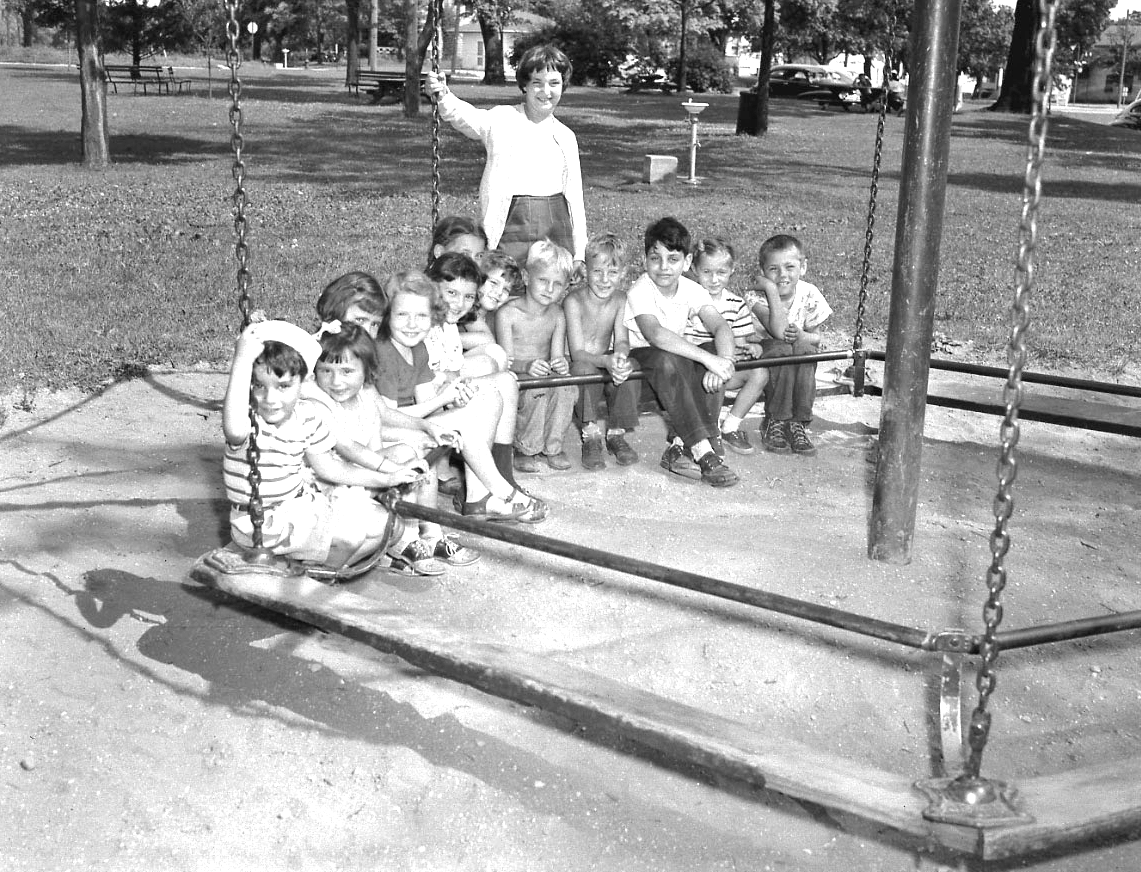
Participants in the City's afternoon recreation program for children age 11 years or younger gather on the merry-go-round at Echo Park in August 1950. The program got off to a late start that summer because of an earlier polio outbreak.
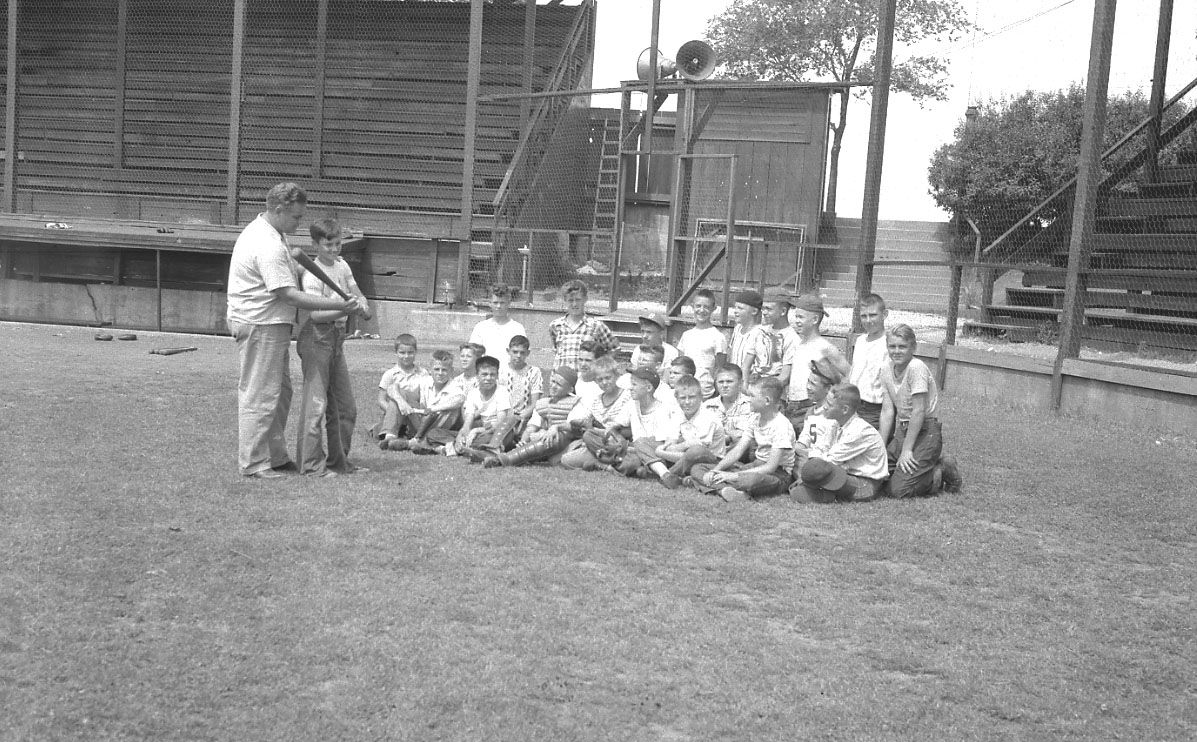
Summer recreation director Eugene VanderBeke gives the older boys some batting tips at the start of the morning program at Athletic Park in July 1950. Among the observers are Wayne Schlitz, Bill Johnson, Wenzel Smetana, Jerry Schilz, Smitty Kerkhoff, Ernie Shaw, Jim Vande Sand, Jerry Bauman, Dave Umnus, Duke Schneider, Dave Bartholf, Dick Killen, and Don Boulden.
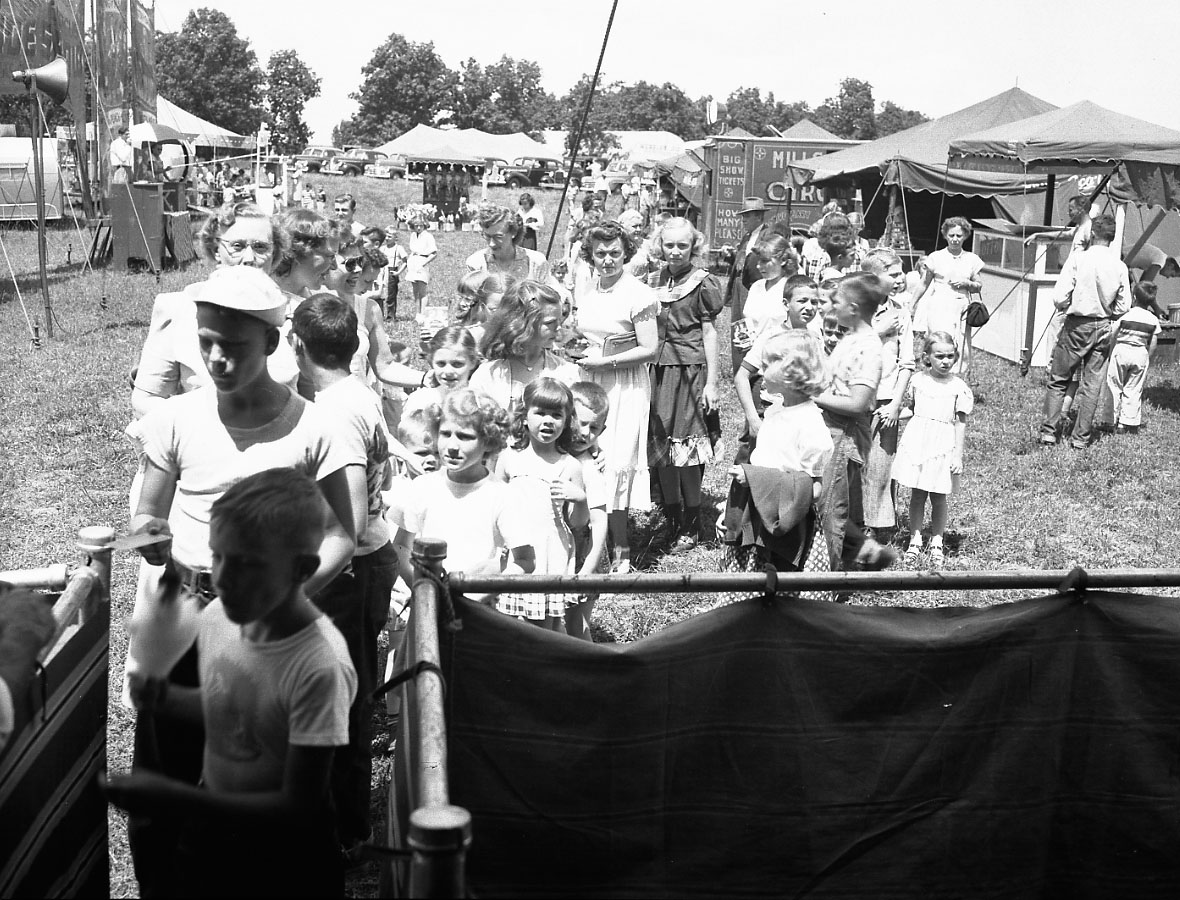
The Mills Brothers Circus appeared at Wereley Field on July 7 under the auspices of the Burlington Lions Club.
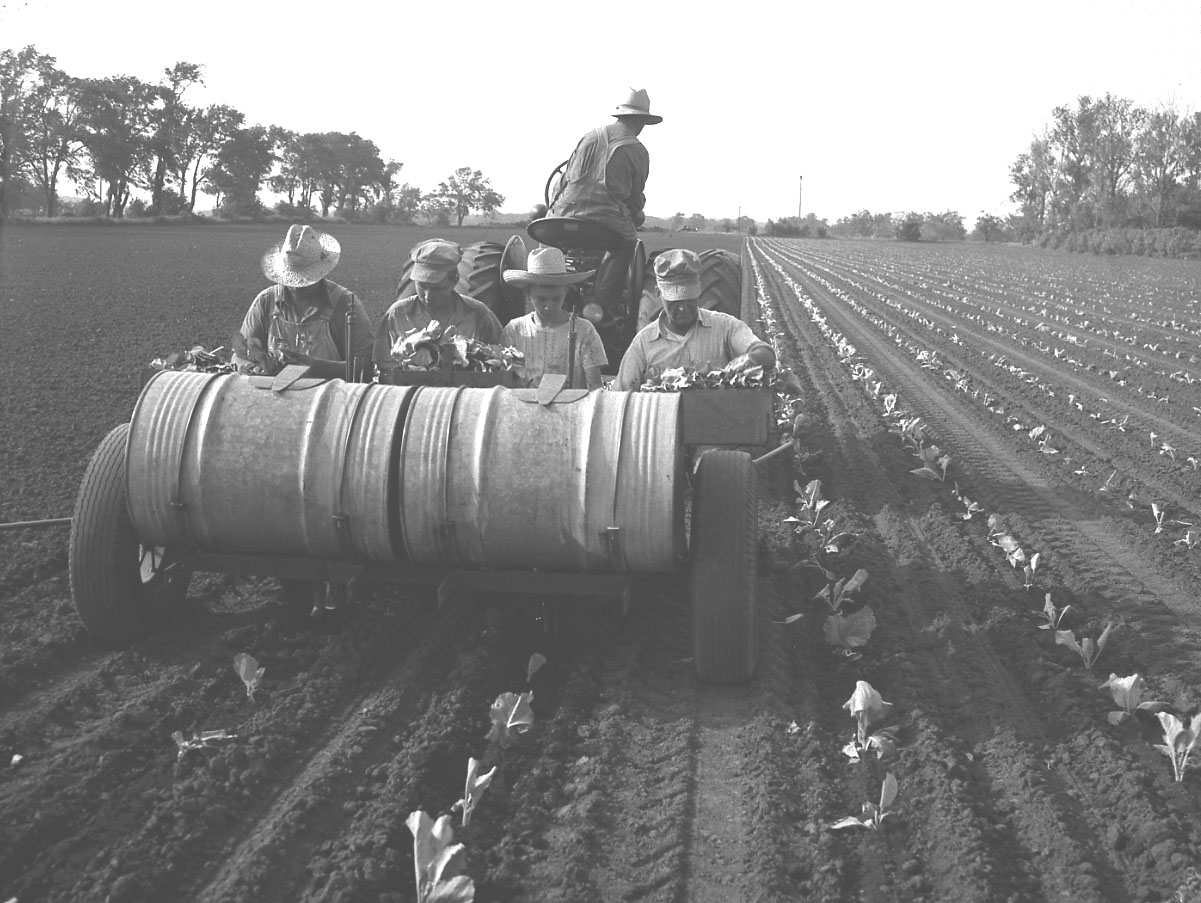
The Richter & Frey Kraut Co. planted row after row of cabbage on the John R.Wilson farm west of Burlington in June 1950 - about 9,000 plants to the acre. Positioning plants on the firm's newly acquired automatic planter are, from left, Clarence Richter, John Cramer, Paul Frey, and George Frey. Theodore Richter is driving the tractor
World War II Ended Cigar Making Industry in Burlington
The following article is from the Standard Democrat of August 7, 1942, less than a year after the United States was drawn into World War II by the Japanese attack on Pearl Harbor. It discusses the demise of a small town industry that had flourished in Burlington for many years.
Last of Local Cigar Makers Closes Shop and Ends Era
War Conditions Force Ted Huening & Co. Out of Business Here
Vanishing like its own rich smoke, the era of the handmade cigar fades a little farther from view this week with the passing of the only remaining cigar manufacturing business in Burlington, operated by Ted Huening, Henry Pfarrdrescher, George Rein and Charles Lightfield.
It was the first world war that started the decline of cigar making by hand, and the second war that is forcing the Burlington concern from the market. In 1917 and 1918, when all available man power had been inducted to military service, manufacturers turned to machines to produce their cigars. In the years following the war they continued to use the machines which were faster and much too expensive to discard, with the result that few young people learned the trade.
Now a second world war has raised tobacco costs 30 per cent, put a ceiling on cigar prices, and made it virtually impossible to get tobacco leaf "wrappers" from Sumatra or to obtain skilled workers. Mr. Huening, like hundreds of cigar makers before him in recent years, is closing out.
He says that he will turn the second floor of his building on Pine street into offices or a flat, and that he has no immediate plans for the future for himself.
The closing, which is to take place Saturday, will mark the end of a lifetime in the cigar making trade. Mr. Huening was born at Waterford, and as a boy tried to get work stripping tobacco in a small Waterford cigar factory for $1.15 a week. Failing, he came to Burlington and hired out stripping tobacco and learning the trade from John Trier who operated a shop at his home, now the Claire Buchan residence on Geneva street.
Retiring with Mr. Huening is Henry Pfarrdrescher, who started work with Mr. Huening in 1916 and has been shop foreman since his return from the world war in 1918. Mr. Pfarrdrescher has accepted a position with Leo Cowley.
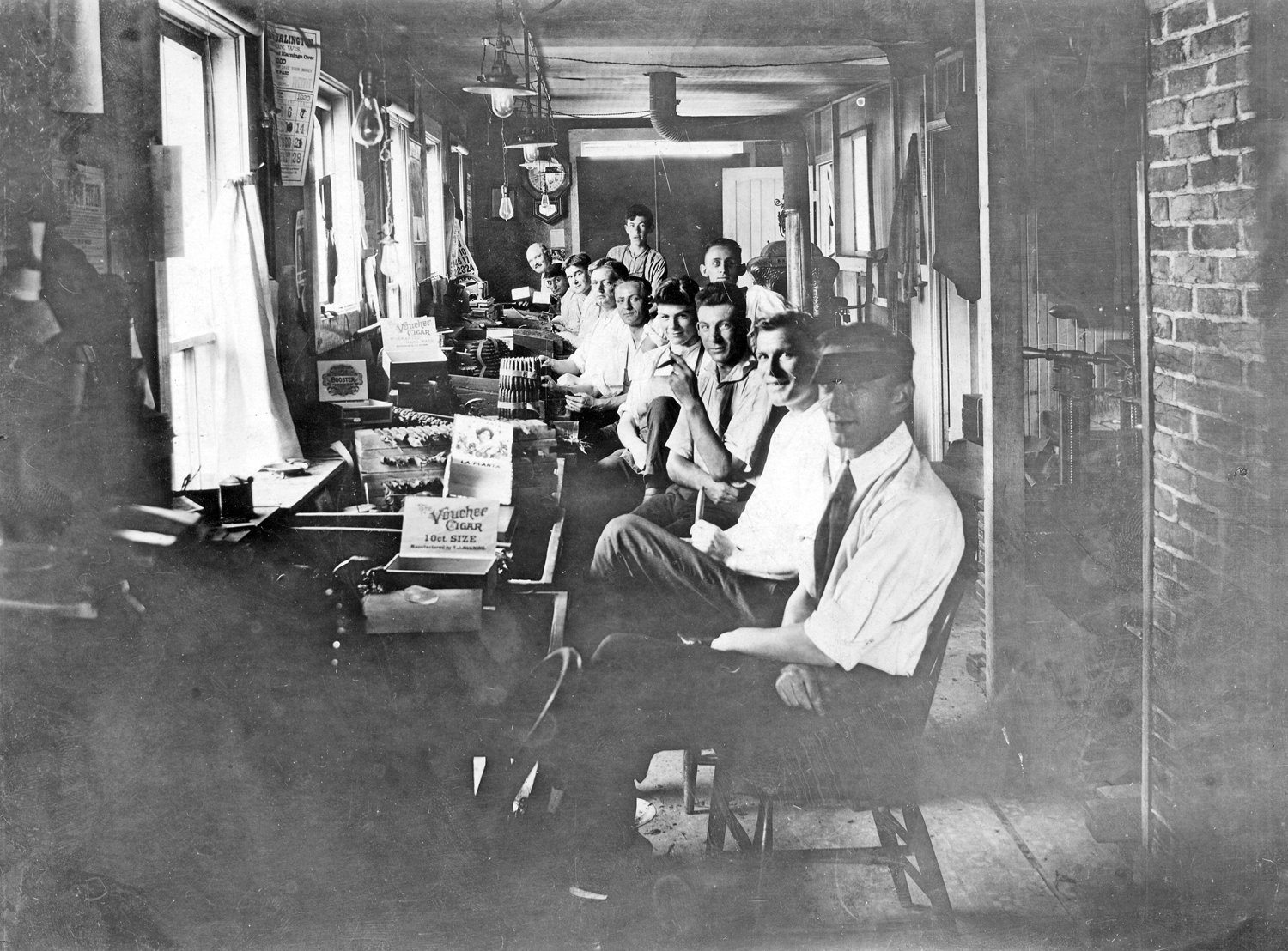
Ted Huening Cigar Factory, 1920. Seated: Henry Pfarrdrescher (front), Ted Huening, John Trier, Fred Krakofsky, Joe Hoffman, John Karcher, George Rein, John Wurms, and Louis Wolf. Standing mid-way is Charles Lightfield. Man standing near back thought to be Ren Yonk.
George Rein has been in the business about 40 years, starting with Ben Holmes and going to the Huening factory when Mr. Huening purchased the business. He has accepted a position with the Murphy Products Co. Mr. Lightfield started the trade in the Al Huse factory and has followed it for thirty years.
In 1913 Mr. Huening started in business for earnest at a shop located at Washington and Dyer streets. There were then no less than seven cigar manu-facturers in Burlington employing a total of 30 workers. In the past 29 years, Mr. Huening has bought out all six of the others, including Ben Holmes, Al. Huse, Wolf & Moe, Tichlofen & Leber, Schuman & Amon, and Adolph Richter.
The largest of the companies, belonging to Ben Holmes, was purchased in 1930, at which time Mr. Huening moved into his present location on Pine street.
About 18 months ago Mr. Pfarrdrescher, Mr. Rein and Mr. Lightfield joined in partnership with Mr. Huening. Since then the four men have done all of their own work, hiring no new employees. As Mr. Huening puts it, there have been no new employees to hire, although at one time there were as many as 14 workers in the shop.
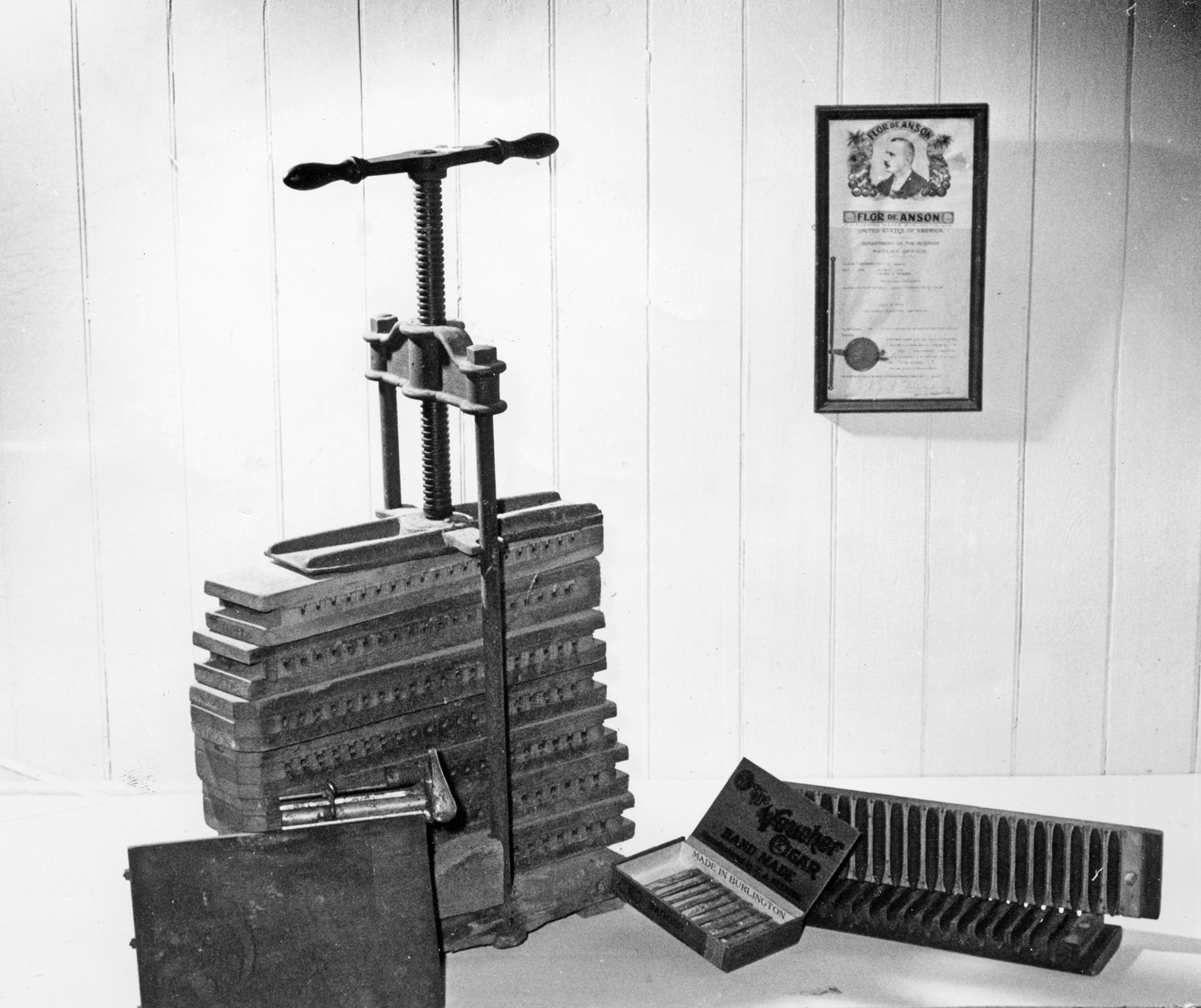
Huening cigar factory artifacts in Society collection include cigar press (with handle), cigar cutter (lower left), Voucher cigar box (lower center) two-piece cigar mold (lower right), and Flor de Anson certificate (upper right).
Changes in the cigar industry in the past 30 years have come mostly in packaging and wrapping, Mr. Huening says. The cigars themselves have remained the same in size, design and blend, but he remembers the day when they were peddled to taverns and stores in baskets by the manufacturer, and counted out by hand for sale. He remembers, too, when the ordinary cigar box that we know was an innovation, and when individual cellophane wrappers were used by his own company for the first time in 1932.
Three kinds of cigars have been put out by the Voucher Co. One, the "Flor de Anson," is a blend acquired in the business transaction with Ben Holmes, and had been made for many years previously by Mr. Holmes’ company. It was named for Cap Anson, a baseball hero of his day, who was a close personal friend of Mr. Holmes, and is the oldest cigar on the market, manufactured continuously since 1890. The other two brands are the popular "Voucher," originated by Mr. Huening and "Margona."
Raw materials have come to the cigar makers from far places: leaf wrappers from Sumatra, domestic tobacco from Connecticut, Pennsylvania and Puerto Rico, and Havana blend from Cuba. The finished product, however, has been sold for the most part within the county, some through jobbers, but largely by the manufacturers direct to retailers and consumers.
Mr. Huening believes strongly that in ten more years the making of cigars by hand will be a lost art. "It takes three years to become a good cigar maker," he explains. "A good man can make 400 cigars in a day, but no one has time or the desire to learn the trade any more."
Within the last year, he has seen a cigar press hung up on the wall of a tavern as a curiosity, labeled, "This is a Cigar Press." He plans to keep one or two of his own, he says, if they are going to become rare museum pieces like that.
It was around 1856 that the first cigar factory was established in Burlington by a Mr. Ropers. It is in 1942 that the last factory is discontinued. Mr. Huening says there will never be another cigar factory in the city; and he is quite sure that the hand craft of cigar making will soon have disappeared from the American scene.
"Old Soldiers Never Die, They Just Fade Away"
Contributed by Priscilla Crowley
Spring is fast approaching and along with spring comes Memorial Day. With everything that is happening in our world today, Memorial Day should have more meaning than ever for us. The number of living World War II vets is dropping drastically day by day. Over 90 crosses were added to their display at Echo Park last year. When you watch these ladies and gentlemen who so proudly served their country stand shoulder to shoulder with the young men and women who are currently serving their country, it literally takes your breath away. They share a bond we can only imagine. Even though the war our older veterans fought is a different war from what is being fought in today’s world, the common denominators are all the same.
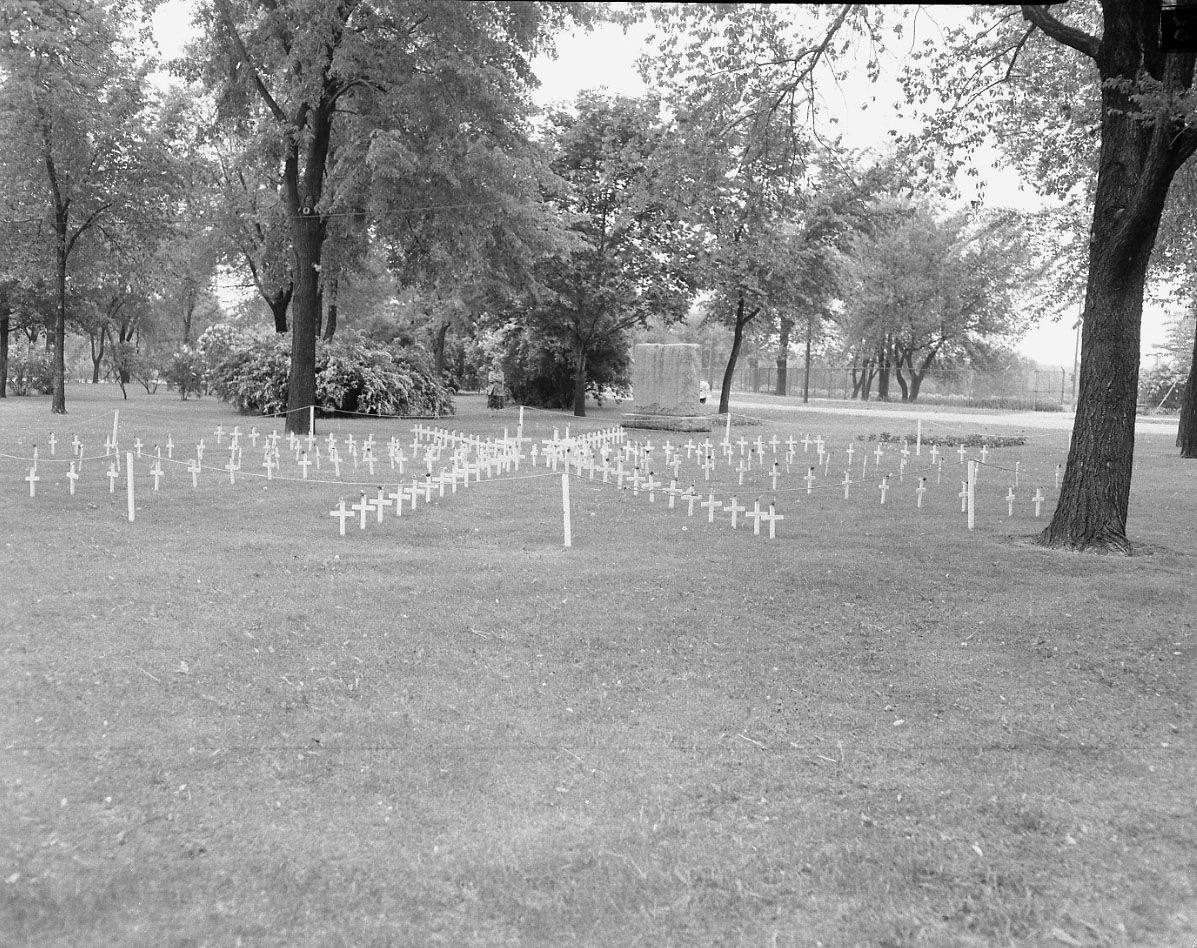
Veterans' crosses in Echo Park, 1953
Our veterans make a number of stops on Memorial Day, including the cemeteries, Mount Carmel Nursing Home, and Pine Brooke Pointe. Over the last couple of years I was privileged to go with them as they visited each of these locations. The stop we made at Pine Brook Pointe touched me very much and brought home to me exactly what this day means to all of our veterans. Waiting patiently in the lobby was an elderly gentleman wearing his full dress uniform from World War II. One of the ladies told me he had been waiting for over an hour – he wanted to make sure he didn’t miss the veterans when they came to do the memorial service. The manager of the facility introduced the visiting veterans to this gentleman and I watched as he painfully pulled himself into an upright position, using his walker for support. He proudly straightened his uniform and shook hands with everyone and asked if he could be a part of their color guard. I watched as this proud veteran made his way slowly outside with the color guard. The guys all slowed their steps so he wouldn’t feel like he was out of step with the rest of them. I can only imagine the physical effort this cost him. Even though this ceremony doesn’t take a great deal of time – to someone like him who has a hard time just getting up out of a chair this must have caused him a great deal of discomfort. The look on his face was absolutely priceless – there he stood with everyone else as straight and as tall as could be proudly taking part in a ceremony that honored all of his fallen comrades from days gone by. When you look upon the faces of these ladies and gentlemen as they take part in these ceremonies, it’s easy to see why they are known as "The Greatest Generation."
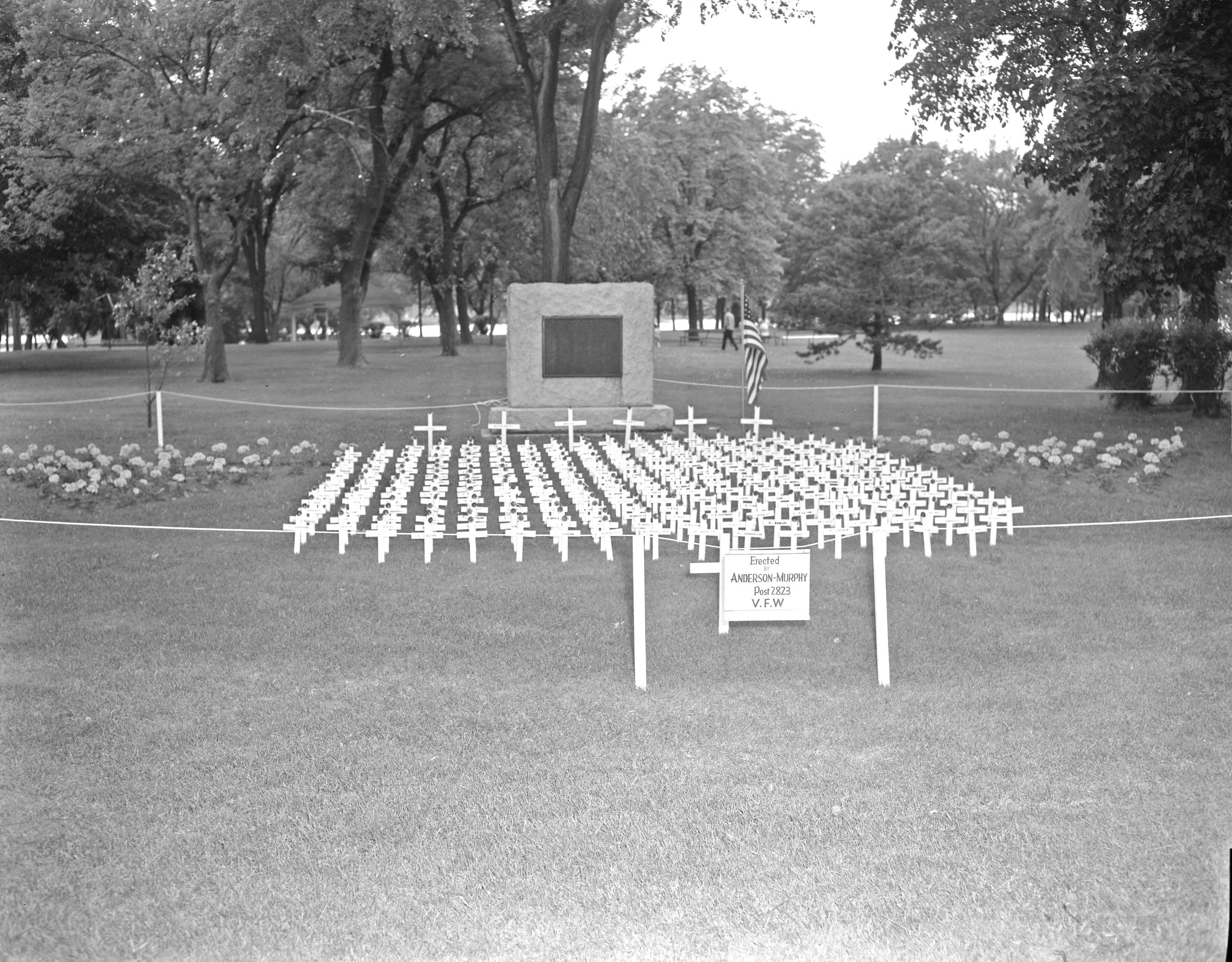
Veterans' crosses in Echo Park, 1963
Last year my Dad’s name was added to the list of those who are no longer with us. Instead of seeing him stand so proudly with everyone else, a simple white cross was his representative. Who will keep these memories alive after they are all gone? I believe it is up to all of us as individuals to help keep this day of remembrance alive and to let future generations know what kinds of sacrifices have been made for them so they can enjoy the freedoms we have in this country. We have young men and women who are still paying the price for freedom. Freedom is not free – there is a price.
I remember listening to stories Mom and Dad told about what it was like during those war years and right afterwards. Those war years changed the way Americans lived and thought and influenced future generations. What we are today is a direct product of what our parents, grandparents, and even great-grandparents endured and sacrificed for all of us. My parents would tell stories about black outs, Victory Gardens, meatless days, gasoline rationing, scrap metal collections, war bonds, women who went to work in factories in the place of men who enlisted and went off to war, and food rationing. I am one of the Baby Boomers who came along after the war. I didn’t live through what they did, by the time I came along, the men were all home and things were changing again. We who came afterwards can only marvel at how the people in this country pulled to together for the war effort, the camaraderie they shared, the sacrifices they all made. If you want a trip down memory lane just listen to the music that was popular in their day. Big Band Era music is a musical history of that time. It’s all there, stories of love, separation, sacrifice, hope, and that unquenchable spirit that personifies America and what it stands for.
While it’s true that Memorial Day is primarily a day of remembering and honoring our fallen soldiers, it is also a day to reflect on those who did not march off to war but rather served at home. The anxiety women must have felt as they watched their children, grandchildren, husbands, or sweethearts leave for
places and adventures unknown must have been at times overwhelming. Not hearing from them for weeks on end, not knowing if they were alive or dead, wounded or perhaps taken prisoner must have been horrendous – but somehow everyone on the homefront got through their lives one day at a time. The people who lived these stories are not from the pages of books; they are friends, neighbors, relatives, people we see every day. Stories about their every day lives need to be heard and we need to hear them. Don’t let this "Greatest Generation" fade into oblivion without hearing what they have to say and passing their stories on to future generations. On Memorial Day, please take a few moments to stop and truly think about what these people have gone through, what they have done for all of us, and let them talk to you about the "old days." What better way to celebrate than sharing a good story?
